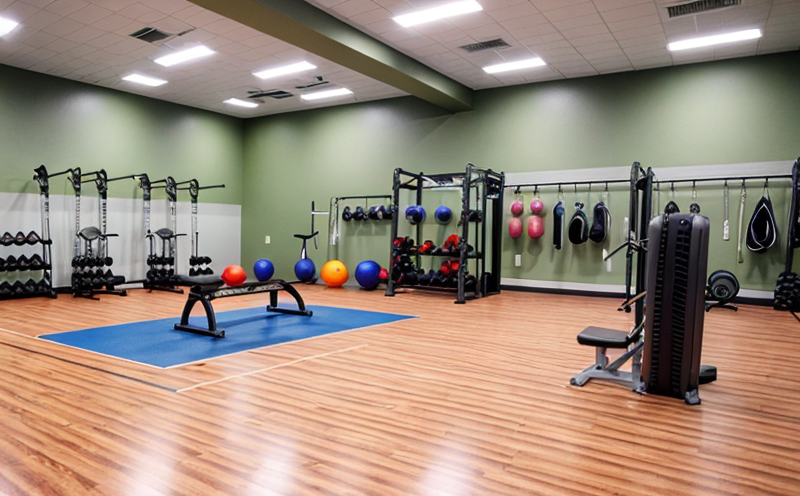Tip-Over Testing of Fitness Machines
The importance of tip-over testing in the fitness equipment industry cannot be overstated. Tip-over incidents are a significant safety concern, especially for home-use machines where children or elderly individuals may be present. The objective of this test is to ensure that exercise equipment remains stable under various stress conditions and does not pose a risk of tipping over during normal use.
Tip-over testing involves simulating real-world scenarios such as the user leaning forward, sitting back, or performing exercises with varying weights. This ensures that even if the machine is subjected to external forces such as wind gusts, an accidental bump, or the impact of a falling object, it remains secure and stable.
For instance, treadmills, ellipticals, stationary bikes, and rowing machines are frequently tested for their stability. The testing process involves placing the equipment on a test platform and applying simulated forces that mimic real-world situations where tip-over risks may occur. The machine’s response to these forces is then carefully monitored.
According to international standards such as ASTM F2645-18, which specifically covers residential exercise equipment stability testing, the criterion for passing a tip-over test requires no more than 30 degrees of tipping and no displacement greater than 1 inch. These stringent requirements ensure that even under extreme conditions, the equipment remains safe and secure.
The implications of failing this type of test are severe. Not only does it jeopardize user safety but also poses a risk to property damage or injury. Compliance with these tests is not just recommended; it’s mandatory for the sale and distribution of fitness equipment in many countries. This is why manufacturers, quality managers, compliance officers, and R&D engineers prioritize this testing.
The testing process involves careful calibration of forces applied at different points on the machine to simulate real-life conditions accurately. The use of sophisticated test stands ensures that even minor discrepancies are detected early in the development phase, allowing for necessary adjustments before full-scale production begins.
In conclusion, tip-over testing is a critical component of ensuring consumer safety and product reliability in the fitness equipment industry. By adhering to strict standards and rigorous testing protocols, manufacturers can ensure their products meet or exceed regulatory requirements, thereby building trust with consumers and maintaining a positive brand reputation.
Why It Matters
The safety of fitness equipment is paramount, especially as more individuals opt for home-based workouts. Tip-over incidents can lead to severe injuries, including fractures, dislocations, and even head trauma if the user falls from a high point on the machine.
Moreover, product liability issues arise when accidents occur due to unstable equipment. Legal action against manufacturers could result in costly lawsuits, reputational damage, and potential recalls. Therefore, compliance with tip-over testing is not just a technical requirement but also a legal necessity.
The psychological impact on consumers cannot be ignored either. If users feel their equipment may not be secure, they are less likely to use it regularly or recommend it to others. This can lead to decreased product sales and customer dissatisfaction. Thus, ensuring the stability of fitness machines through rigorous testing is crucial for maintaining brand loyalty and market share.
From a broader societal perspective, reducing tip-over incidents contributes to public health by encouraging more people to engage in regular physical activity safely. Properly designed and tested equipment reduces accidents and injuries, promoting healthier lifestyles overall.
Scope and Methodology
| Test Parameters | Description |
|---|---|
| Force Application Points | The test stands apply forces at multiple points along the width and length of the machine to simulate real-world conditions. |
| Load Variations | The weight simulators are adjusted to replicate different user weights, including peak loads during exercise. |
| Tipping Angle Measurement | A calibrated angle gauge measures the maximum tipping angle achieved under test conditions. |
| Displacement Monitoring | The displacement of the machine is monitored using precision sensors to ensure no lateral movement beyond acceptable limits. |
The testing procedure begins with the equipment being placed on a sturdy test stand. The forces are then gradually increased until the tipping angle and displacement values reach predefined thresholds. If any part of the machine moves past these limits, it fails the test.
Once the tests are complete, detailed reports are generated that document all relevant data points, including force application rates, maximum tipping angles, and any deviations from standard operating procedures. These reports provide valuable insights into equipment performance and help guide design improvements.
Use Cases and Application Examples
| Equipment Type | Description of Use Case |
|---|---|
| Treadmills | In a home setting, users may lean forward or sit down abruptly while adjusting the speed. The test simulates these actions to ensure stability. |
| Stationary Bikes | The user might stop suddenly during an intense workout session, causing unexpected lateral forces on the equipment. Testing ensures it remains secure. |
| Ellipticals | During a workout, users may shift their weight or apply pressure to the handlebars. The test replicates these movements for stability verification. |
| Rowing Machines | The user's body weight and the resistance settings can create significant forces on the equipment. Testing ensures it remains stable under all conditions. |
In an industrial setting, such as a gym or fitness center, additional considerations are made to accommodate higher foot traffic and more frequent use. The tests account for these variables by increasing the frequency of force applications and monitoring the equipment’s performance over extended periods.
For example, a home treadmill might be tested with one user applying maximum forces, while an industrial treadmill could involve multiple users testing it simultaneously to ensure continuous stability under peak load conditions. This ensures that even in high-demand environments, fitness machines remain safe and reliable.





